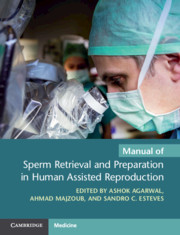Book contents
- Manual of Sperm Retrieval and Preparation in Human Assisted Reproduction
- Cambridge Laboratory Manuals in Assisted Reproductive Technology
- Manual of Sperm Retrieval and Preparation in Human Assisted Reproduction
- Copyright page
- Dedication
- Contents
- Contributors
- Editor Biographies
- Preface
- Part I Introduction
- Part II Sperm Retrieval
- Part III Laboratory Handling of Retrieved Sperm
- Chapter 11 Critical Factors for Optimizing Sperm Handling and ICSI Outcomes
- Chapter 12 Sperm Cryopreservation
- Chapter 13 Future Directives in Sperm Handling for ART
- Index
- References
Chapter 13 - Future Directives in Sperm Handling for ART
from Part III - Laboratory Handling of Retrieved Sperm
Published online by Cambridge University Press: 09 April 2021
- Manual of Sperm Retrieval and Preparation in Human Assisted Reproduction
- Cambridge Laboratory Manuals in Assisted Reproductive Technology
- Manual of Sperm Retrieval and Preparation in Human Assisted Reproduction
- Copyright page
- Dedication
- Contents
- Contributors
- Editor Biographies
- Preface
- Part I Introduction
- Part II Sperm Retrieval
- Part III Laboratory Handling of Retrieved Sperm
- Chapter 11 Critical Factors for Optimizing Sperm Handling and ICSI Outcomes
- Chapter 12 Sperm Cryopreservation
- Chapter 13 Future Directives in Sperm Handling for ART
- Index
- References
Summary
Couple infertility is gradually increasing, and couples unable to conceive naturally are dependent on assisted reproductive techniques (ART). Intracytoplasmic sperm injection (ICSI) bypasses the natural selection process of sperm in the female reproductive tract, hence sperm-handling techniques are used to select the most suitable sperm for oocyte fertilization. In this chapter we discuss the conventional sperm-processing methods such as swim-up and density gradient centrifugation. Furthermore, advanced techniques such as magnetic-activated cell sorting, microfluidic devices, motile sperm organelle morphology examination, flow cytometry, and zeta potential are presented. We provide an overview of the sperm-handling approach and its outcome in ART. Additionally, we highlight the future sperm-handling techniques such as Raman spectrometry, interferometric phase microscopy, confocal light absorption and scattering spectroscopy, proteomic analysis, and peptide-based selection of sperm.
Keywords
- Type
- Chapter
- Information
- Publisher: Cambridge University PressPrint publication year: 2021

